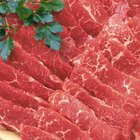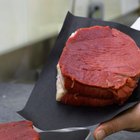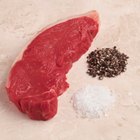karandaev/iStock/GettyImages
London broil refers more to a technique than a specific cut of meat, kind of like how steak Diane refers to flambeed steak and cognac sauce but doesn't refer to a singular cut. Classically, a London broil was a flank steak, but now you'll find broil recipes that call for skirt or top round. That said, you can apply the London broil technique to any steak, even the pricey tenderloin and ribeye, but why would you, when cheap cuts work best?
The Cuts
The beauty of London broil lies in its resourcefulness, or, rather, the resourcefulness of the cooks who made it a household name. By cooking naturally tough, relatively thin cuts (3/4- to 1-inch thick) of meat such as skirt, flank or round steak quickly using high heat and slicing it across the grain, you get all the tenderness you need.
The Marinade
The marinade used in London broil introduces flavor more than tenderness. Acidic marinades, in fact, have little effect on tough beef; for maximum tenderization, you need the enzyme action that comes from lactose or early, heavy salting.
London broil marinades commonly use a vegetable or olive oil base, a salty or acidic primary flavoring such as Worcestershire sauce or soy sauce, and aromatic secondary flavorings, such as balsamic, Dijon mustard and fresh herbs, to bolster everything. You can use any marinade you like. If you want to go a traditional route, mix 4 tablespoons each Dijon, balsamic vinegar and lemon juice with 2/3 cup of olive oil and season to taste with fresh herbs, kosher salt and freshly ground black pepper.
If you want to tenderize the steak, use a 48-blade tenderizer, such as that made by Jaccard. Stamp the flank, round or skirt steak three or four times on each side before adding it to the marinade.
The Method
Go quick or go home when it comes to cooking London broil. Perhaps unsurprisingly, this means using the broiler. You want to keep the cooking time to under five minutes each side; if you cook skirt, flank or round further than to medium, it gets tough.
And although you can slow-cook a marinated skirt, flank or round steak in a 350F oven, in an oven bag, or in a Dutch oven, it doesn't make it a London broil. The same goes for serving. London broil calls for quickly cooked, marinated beef sliced across the grain into thin pieces.
Marinate
Again, use any steak you like, but go with flank steak first and see what it does for you. If you want more tenderness, try sirloin. Whatever steak you choose, go with a one that measures approximately 3/4- to 1-inch thick, like the naturally thin flank and skirt steak are.
Broil
Set the oven rack 3 to 4 inches below the broiler and set the steak in an oven-safe dish. Next, broil the steak for four minutes on each side for medium rare; five minutes on each side will give you medium.
Rest and Slice
Resting the steak for five minutes after cooking it is imperative for the most juiciness. Slice the steak using a long, sharp knife (non-serrated) into 1 1/2-inch-wide slices.
Related Articles

How to Grill London Broil

Do You Need to Marinate Flat Iron Steak ...

How to Cook a Petite Filet of Beef in ...

How to Get Skirt Steak Tender
The Best Way to Cook Bison Steak

How to Grill a Ribeye on a Weber Q

Tips to Marinate a T-Bone Steak

How to Broil Filet Mignon Wrapped in ...

How to Cook London Broil

How to Cook Venison Backstrap Steaks on ...
How to Cook Beef Chuck Underblade

How to Slice Round Steak for Jerky

What Is Rump Steak?
What Is the Best Way to Cook Swordfish?

Ways to Cook Thinly Sliced Beef Steak

How to Make a Pepper Steak Tender

How to Barbeque a Brisket on a Gas Grill

How Long Do You Cook Whole Deer ...

How Long Does It Take to Bake Minute ...
How to Cook Boneless Top Chuck Steak in ...
References
Resources
Writer Bio
A.J. Andrews' work has appeared in Food and Wine, Fricote and "BBC Good Food." He lives in Europe where he bakes with wild yeast, milks goats for cheese and prepares for the Court of Master Sommeliers level II exam. Andrews received formal training at Le Cordon Bleu.